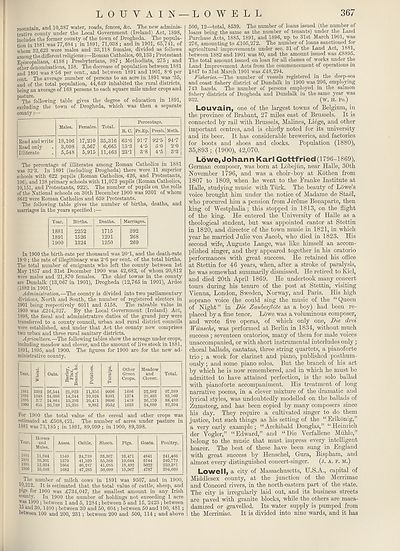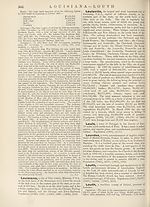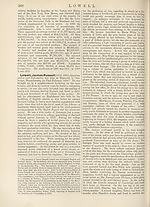New volumes of the Encyclopædia Britannica > Volume 30, K-MOR
(397) Page 367
Download files
Complete book:
Individual page:
Thumbnail gallery: Grid view | List view

LOUVAIN — LOWELL 367
mountain, and 10,387 water, roads, fences, &c. The new adminis¬
trative county under the Local Government (Ireland) Act, 1898,
includes the former county of the town of Drogheda. The popula¬
tion in 1881 was 77,684 ; in 1891, 71,038 ; and in 1901, 65,741, of
whom 32,623 were males and 33,118 females, divided as follows
amon" the different religions:—Roman Catholics, 60,133; Protestant
Episcopalians, 4188 ; Presbyterians, 987 ; Methodists, 275 ; and
other denominations, 158. The decrease of population between 1881
and 1891 was 8’56 per cent., and between 1891 and 1901, 8’6 per
cent. The average number of persons to an acre in 1891 was ’35,
and "of the total population, 44,649 inhabited the rural districts,
being an average of 168 persons to each square mile under crops and
pasture.
The following table gives the degree of education in 1891,
excluding the town of Drogheda, which was then a separate
county:—
Read and write
Read only
Illiterate
Males.
18,106
3,098
5,548
Females.
17,210
3,567
5,915
Total.
35,316
6,665
11,463
Percentage.
It. C. Pr.Ep. Presb. | Meth
63-6
13-3
23-1
91-7
4-5
3'8
92-5
3- 0
4- 5
94-7
2-0
3-3
The percentage of illiterates among Roman Catholics in 1881
was 32'3. In 1891 (including Drogheda) there were 11 superior
schools with 622 pupils (Roman Catholics, 426, and Protestants,
196), and 128 primary schools with 11,073 pupils (Roman Catholics,
10,151, and Protestants, 922). The number of pupils on the rolls
of the National schools on 30th December 1900 was 9301' of whom
8642 were Roman Catholics and 659 Protestants.
The following table gives the number of births, deaths, and
marriages in the years specified :—
In 1900 the birth-rate per thousand was 20'1, and the death-rate
19-0 ; the rate of illegitimacy was 2-6 per cent, of the total births.
The total number of emigrants who left the county between 1st
May 1857 and 31st December 1900 was 42,682, of whom 20,812
were males and 21,870 females. The chief towns in the county
are Dundalk (13,067 in 1901), Drogheda (12,765 in 1901), Ardee
(1882 in 1901).
Administration.—The county is divided into two parliamentary
divisions, North and South, the number of registered electors in
1901 being respectively 6011 and 5158. The rateable value in
1900 was £244,327. By the Local Government (Ireland) Act,
1898, the fiscal and administrative duties of the grand jury were
transferred to a county council, urban and rural district councils
were established, and under that Act the county now comprises
two urban and three rural sanitary districts.
Agriculture.—The following tables show the acreage under crops,
including meadow and clover, and the amount of live stock in 1881,
1891, 1895, and 1900. The figures for 1900 are for the new ad¬
ministrative county.
Year.
1SS1
1891
1895
1900
Oats.
3382
1048
377
655
26,544
24,086
24,864
20,789
47
<V X ~
T} in £
PQ 03
n
21,923
14,344
15,293
15,205
PH
11,356
10,824
10,471
9,881
9906
8391
9896
9332
Other
Green
Crops.
1696
1374
1418
1633
Meadow
and
Clover.
22,582
23,493
26,170
24,889
Total.
97,389
83,560
88,489
82,394
For 1900 the total value of the cereal and other crops was
estimated at £508,421. The number of acres under pasture in
1881 was 73,185 ; in 1891, 89,099 ; in 1900, 89,398.
Year.
1SS1
1891
1895
1900
Horses
and
Mules.
11,044
10,301
12,034
10,688
Asses.
1549
1570
1664
1682
Cattle.
34,739
41,520
46,247
47,285
Sheen.
33,367
55,388
41,085
50,099
Pigs.
10.471
19,644
18,492
15,967
Goats.
4841
5744
5022
4787
Poultry.
241,466
240,779
259,381
294,009
The number of milch cows in 1891 was 9507, and in 1900,
10,212. It is estimated that the total value of cattle, sheep, and
pigs for 1900 was £734,047, the smallest amount in any Irish
county. In 1900 the number of holdings not exceeding 1 acre
was 1990 ; between 1 and 5, 1284 ; between 5 and 15, 2423 ; between
15 and 30, 1400 ; between 30 and 50, 604 ; between 50 and 100, 481 ;
between 100 and 200, 231 ; between 200 and 500, 114 ; and above
500, 12—total, 8539. The number of loans issued (the number of
loans being the same as the number of tenants) under the Land
Purchase Acts, 1885, 1891, and 1896, up to 31st March 1901, was
276, amounting to £105,272. The number of loans sanctioned for
agricultural improvements under sec. 31 of the Land Act, 1881,
between 1882 and 1901 was 80, and the amount issued was £8895.
The total amount issued on loan for all classes of works under the
Land Improvement Acts from the commencement of operations in
1847 to 31st March 1901 was £48,294.
Fisheries.—The number of vessels registered in the deep-sea
and coast fishery district of Dundalk in 1900 was 206, employing
743 hands. The number of persons employed in the salmon
fishery districts of Drogheda and Dundalk in the same year was
932. (w. H. Po.)
Louvain, one of the largest towns of Belgium, in
the province of Brabant, 27 miles east of Brussels. It is
connected by rail with Brussels, Malines, Liege, and other
important centres, and is chiefly noted for its university
and its beer. It has considerable breweries, and factories
for boots and shoes and clocks. Population (1880),
35,893; (1900), 42,070.
Lowe, Johann Karl Gottfried(1796-1869),
German composer, was born at Lobejiin, near Halle, 30th
November 1796, and was a choir-boy at Kb then from
1807 to 1809, when he went to the Franke Institute at
Halle, studying music with Turk. The beauty of Lowe’s
voice brought him under the notice of Madame de Stael,
who procured him a pension from Jerome Bonaparte, then
king of Westphalia; this stopped in 1813, on the flight
of the king. He entered the University of Halle as a
theological student, but was appointed cantor at Stettin
in 1820, and director of the town music in 1821, in which
year he married Julie von Jacob, who died in 1823. His
second wife, Auguste Lange, was like himself an accom¬
plished singer, and they appeared together in his oratorio
performances with great success. He retained his office
at Stettin for 46 years, when, after a stroke of paralysis,
he was somewhat summarily dismissed. He retired to Kiel,
and died 20th April 1869. He undertook many concert
tours during his tenure of the post at Stettin, visiting
Vienna, London, Sweden, Norway, and Paris. His high
soprano voice (he could sing the music of the “ Queen
of Night” in Die Zauberjiote as a boy) had been re¬
placed by a fine tenor. Lowe was a voluminous composer,
and wrote five operas, of which only one, Die drei
Wiinsche, was performed at Berlin in 1834, without much
success; seventeen oratorios, many of them for male voices
unaccompanied, or with short instrumental interludes only ;
choral ballads, cantatas, three string quartets, a pianoforte
trio; a work for clarinet and piano, published posthum¬
ously ; and some piano solos. But the branch of his art
by which he is now remembered, and in which he must be
admitted to have attained perfection, is the solo ballad
with pianoforte accompaniment. His treatment of long
narrative poems, in a clever mixture of the dramatic and
lyrical styles, was undoubtedly modelled on the ballads of
Zumsteeg, and has been copied by many composers since
his day. They require a cultivated singer to do them
justice, but such things as his setting of the “Erlkomg,”
a very early example; “Archibald Douglas,” “Heinrich
der Vogler,” “Edward,” and “Die Verfallene Mrihle,”
belong to the music that must impress every intelligent
hearer. The best of these have been sung in England
with great success by Henschel, Gura, Bispham, and
almost every distinguished concert-singer. (j. A. F. M.)
Lowell, a city of Massachusetts, U.S.A., capital of
Middlesex county, at the junction of the Merrimac
and Concord rivers, in the north-eastern part of the state.
The city is irregularly laid out, and its business streets
are paved with granite blocks, while the others are maca¬
damized or gravelled. Its water supply is pumped from
the Merrimac. It is divided into nine wards, and it has
mountain, and 10,387 water, roads, fences, &c. The new adminis¬
trative county under the Local Government (Ireland) Act, 1898,
includes the former county of the town of Drogheda. The popula¬
tion in 1881 was 77,684 ; in 1891, 71,038 ; and in 1901, 65,741, of
whom 32,623 were males and 33,118 females, divided as follows
amon" the different religions:—Roman Catholics, 60,133; Protestant
Episcopalians, 4188 ; Presbyterians, 987 ; Methodists, 275 ; and
other denominations, 158. The decrease of population between 1881
and 1891 was 8’56 per cent., and between 1891 and 1901, 8’6 per
cent. The average number of persons to an acre in 1891 was ’35,
and "of the total population, 44,649 inhabited the rural districts,
being an average of 168 persons to each square mile under crops and
pasture.
The following table gives the degree of education in 1891,
excluding the town of Drogheda, which was then a separate
county:—
Read and write
Read only
Illiterate
Males.
18,106
3,098
5,548
Females.
17,210
3,567
5,915
Total.
35,316
6,665
11,463
Percentage.
It. C. Pr.Ep. Presb. | Meth
63-6
13-3
23-1
91-7
4-5
3'8
92-5
3- 0
4- 5
94-7
2-0
3-3
The percentage of illiterates among Roman Catholics in 1881
was 32'3. In 1891 (including Drogheda) there were 11 superior
schools with 622 pupils (Roman Catholics, 426, and Protestants,
196), and 128 primary schools with 11,073 pupils (Roman Catholics,
10,151, and Protestants, 922). The number of pupils on the rolls
of the National schools on 30th December 1900 was 9301' of whom
8642 were Roman Catholics and 659 Protestants.
The following table gives the number of births, deaths, and
marriages in the years specified :—
In 1900 the birth-rate per thousand was 20'1, and the death-rate
19-0 ; the rate of illegitimacy was 2-6 per cent, of the total births.
The total number of emigrants who left the county between 1st
May 1857 and 31st December 1900 was 42,682, of whom 20,812
were males and 21,870 females. The chief towns in the county
are Dundalk (13,067 in 1901), Drogheda (12,765 in 1901), Ardee
(1882 in 1901).
Administration.—The county is divided into two parliamentary
divisions, North and South, the number of registered electors in
1901 being respectively 6011 and 5158. The rateable value in
1900 was £244,327. By the Local Government (Ireland) Act,
1898, the fiscal and administrative duties of the grand jury were
transferred to a county council, urban and rural district councils
were established, and under that Act the county now comprises
two urban and three rural sanitary districts.
Agriculture.—The following tables show the acreage under crops,
including meadow and clover, and the amount of live stock in 1881,
1891, 1895, and 1900. The figures for 1900 are for the new ad¬
ministrative county.
Year.
1SS1
1891
1895
1900
Oats.
3382
1048
377
655
26,544
24,086
24,864
20,789
47
<V X ~
T} in £
PQ 03
n
21,923
14,344
15,293
15,205
PH
11,356
10,824
10,471
9,881
9906
8391
9896
9332
Other
Green
Crops.
1696
1374
1418
1633
Meadow
and
Clover.
22,582
23,493
26,170
24,889
Total.
97,389
83,560
88,489
82,394
For 1900 the total value of the cereal and other crops was
estimated at £508,421. The number of acres under pasture in
1881 was 73,185 ; in 1891, 89,099 ; in 1900, 89,398.
Year.
1SS1
1891
1895
1900
Horses
and
Mules.
11,044
10,301
12,034
10,688
Asses.
1549
1570
1664
1682
Cattle.
34,739
41,520
46,247
47,285
Sheen.
33,367
55,388
41,085
50,099
Pigs.
10.471
19,644
18,492
15,967
Goats.
4841
5744
5022
4787
Poultry.
241,466
240,779
259,381
294,009
The number of milch cows in 1891 was 9507, and in 1900,
10,212. It is estimated that the total value of cattle, sheep, and
pigs for 1900 was £734,047, the smallest amount in any Irish
county. In 1900 the number of holdings not exceeding 1 acre
was 1990 ; between 1 and 5, 1284 ; between 5 and 15, 2423 ; between
15 and 30, 1400 ; between 30 and 50, 604 ; between 50 and 100, 481 ;
between 100 and 200, 231 ; between 200 and 500, 114 ; and above
500, 12—total, 8539. The number of loans issued (the number of
loans being the same as the number of tenants) under the Land
Purchase Acts, 1885, 1891, and 1896, up to 31st March 1901, was
276, amounting to £105,272. The number of loans sanctioned for
agricultural improvements under sec. 31 of the Land Act, 1881,
between 1882 and 1901 was 80, and the amount issued was £8895.
The total amount issued on loan for all classes of works under the
Land Improvement Acts from the commencement of operations in
1847 to 31st March 1901 was £48,294.
Fisheries.—The number of vessels registered in the deep-sea
and coast fishery district of Dundalk in 1900 was 206, employing
743 hands. The number of persons employed in the salmon
fishery districts of Drogheda and Dundalk in the same year was
932. (w. H. Po.)
Louvain, one of the largest towns of Belgium, in
the province of Brabant, 27 miles east of Brussels. It is
connected by rail with Brussels, Malines, Liege, and other
important centres, and is chiefly noted for its university
and its beer. It has considerable breweries, and factories
for boots and shoes and clocks. Population (1880),
35,893; (1900), 42,070.
Lowe, Johann Karl Gottfried(1796-1869),
German composer, was born at Lobejiin, near Halle, 30th
November 1796, and was a choir-boy at Kb then from
1807 to 1809, when he went to the Franke Institute at
Halle, studying music with Turk. The beauty of Lowe’s
voice brought him under the notice of Madame de Stael,
who procured him a pension from Jerome Bonaparte, then
king of Westphalia; this stopped in 1813, on the flight
of the king. He entered the University of Halle as a
theological student, but was appointed cantor at Stettin
in 1820, and director of the town music in 1821, in which
year he married Julie von Jacob, who died in 1823. His
second wife, Auguste Lange, was like himself an accom¬
plished singer, and they appeared together in his oratorio
performances with great success. He retained his office
at Stettin for 46 years, when, after a stroke of paralysis,
he was somewhat summarily dismissed. He retired to Kiel,
and died 20th April 1869. He undertook many concert
tours during his tenure of the post at Stettin, visiting
Vienna, London, Sweden, Norway, and Paris. His high
soprano voice (he could sing the music of the “ Queen
of Night” in Die Zauberjiote as a boy) had been re¬
placed by a fine tenor. Lowe was a voluminous composer,
and wrote five operas, of which only one, Die drei
Wiinsche, was performed at Berlin in 1834, without much
success; seventeen oratorios, many of them for male voices
unaccompanied, or with short instrumental interludes only ;
choral ballads, cantatas, three string quartets, a pianoforte
trio; a work for clarinet and piano, published posthum¬
ously ; and some piano solos. But the branch of his art
by which he is now remembered, and in which he must be
admitted to have attained perfection, is the solo ballad
with pianoforte accompaniment. His treatment of long
narrative poems, in a clever mixture of the dramatic and
lyrical styles, was undoubtedly modelled on the ballads of
Zumsteeg, and has been copied by many composers since
his day. They require a cultivated singer to do them
justice, but such things as his setting of the “Erlkomg,”
a very early example; “Archibald Douglas,” “Heinrich
der Vogler,” “Edward,” and “Die Verfallene Mrihle,”
belong to the music that must impress every intelligent
hearer. The best of these have been sung in England
with great success by Henschel, Gura, Bispham, and
almost every distinguished concert-singer. (j. A. F. M.)
Lowell, a city of Massachusetts, U.S.A., capital of
Middlesex county, at the junction of the Merrimac
and Concord rivers, in the north-eastern part of the state.
The city is irregularly laid out, and its business streets
are paved with granite blocks, while the others are maca¬
damized or gravelled. Its water supply is pumped from
the Merrimac. It is divided into nine wards, and it has
Set display mode to:
![]() Universal Viewer |
Universal Viewer | ![]() Mirador |
Large image | Transcription
Mirador |
Large image | Transcription
Images and transcriptions on this page, including medium image downloads, may be used under the Creative Commons Attribution 4.0 International Licence unless otherwise stated. ![]()
| Encyclopaedia Britannica > New volumes of the Encyclopædia Britannica > Volume 30, K-MOR > (397) Page 367 |
|---|
| Permanent URL | https://digital.nls.uk/193572662 |
|---|
| Attribution and copyright: |
|
|---|---|
| Shelfmark | EB.18 |
|---|---|
| Description | Ten editions of 'Encyclopaedia Britannica', issued from 1768-1903, in 231 volumes. Originally issued in 100 weekly parts (3 volumes) between 1768 and 1771 by publishers: Colin Macfarquhar and Andrew Bell (Edinburgh); editor: William Smellie: engraver: Andrew Bell. Expanded editions in the 19th century featured more volumes and contributions from leading experts in their fields. Managed and published in Edinburgh up to the 9th edition (25 volumes, from 1875-1889); the 10th edition (1902-1903) re-issued the 9th edition, with 11 supplementary volumes. |
|---|---|
| Additional NLS resources: |
|

